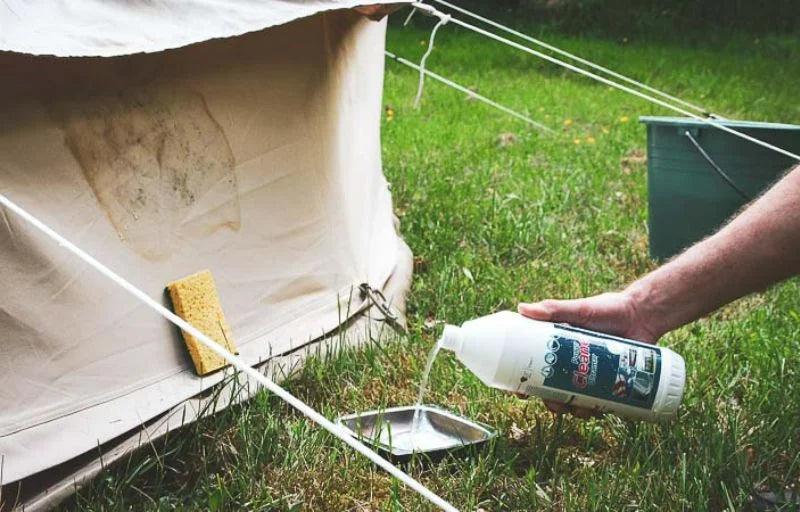Why does your tent turn into trash within six months, while mine still looks brand new after three years? Today, I’ll reveal three essential secrets to making your tent last like Captain America——I don’t tell the average person!
Material Determines Durability: Is Your Tent Fast Fashion or a Classic?
A tent’s lifespan is largely determined the moment it leaves the factory. No matter how well you maintain it, poor-quality materials will always have a short lifespan. Choosing the right material is like picking the right DNA—it directly affects your tent’s durability.
PU-Coated Tents: Affordable but Fragile
PU coated tents: Common material for low-end tents, affordable but "fragile". When stored in high temperature and high humidity environments, the PU coating may fall off in a year or two, causing waterproof failure and brittle fabric, just like the "crispy ice cream cones" you buy at KFC. However, the life of the tent can be extended through proper maintenance (such as regular application of waterproofing agent).
Nylon vs. Polyester: Which One Suits Your Needs?
- Nylon: Lightweight and ideal for backpacking, but less UV-resistant and more prone to degradation. If you need a high-performance tent for mountaineering, opt for silicone-coated nylon (Silnylon) for added strength and water resistance.
- Polyester: Higher tensile strength, better UV resistance, and lower water absorption make it the preferred choice for rooftop tents and long-term outdoor use. It’s a great option for frequent campers or those tackling harsher environments.
Rooftop Tent Materials: What to Watch Out For
- Note for rooftop tents: Low-end aluminum alloys are light and cheap, but they may become brittle in extremely cold environments. Ask clearly when purchasing and be responsible for your own safety! Fiberglass is hardcore but bulky. Choosing the wrong material may cause the tent to "break" during bumps, so it is very important to choose your own "wild companion".
Even the Best Tent Needs Proper Care—Just Like Your Hair!
Tent-Killing Mistakes You Should Avoid
- Packing a wet tent: Storing a damp tent in a compression bag is like throwing a fungus party. Mold growth can weaken the fabric and degrade waterproof coatings(Mold is not only harmful to your tent, but also to your health!).
- Long-term UV exposure: The sun’s UV rays are your tent’s worst enemy, causing fading and weakening fabrics in just one season.
- Washing in a machine: Tossing your tent into a washing machine will ruin the zippers, damage coatings, and turn it into a disposable item.
Pro Tips for a Long-Lasting Tent
- Keep it dry: Always air-dry your tent after use. Open seams while drying to prevent hidden moisture buildup. If you camp in humid climates, using a dehumidifier during storage can help.
- Smart storage; Avoid overstuffing your tent bag, which can stress the fabric and promote mold growth.
- Cleaning do’s and don’ts: Use mild soap and a soft brush for stubborn stains. Avoid harsh chemicals like toilet cleaners or abrasive scrubbing tools—Unless you can accept using steel wool to rub back and forth on your body.
Emergency Fixes: Extend Your Tent’s Lifespan
Dealing with Mold & Mildew
- Use mild soap or a specialized tent cleaner with a soft brush.
- Rinse thoroughly and air-dry before applying an anti-mildew spray.
Waterproofing Repairs
- PU coating repair: Coating peeled off? PU coating can be repaired by low-temperature ironing (be sure to put cotton cloth at the bottom), but silicone coating (Silnylon) cannot be ironed. It is recommended to directly re-apply waterproof agent (such as Gear Aid Seam Grip+WP).
- Silnylon tents: Never iron! Instead, apply a silicone-based waterproofing treatment (e.g., Gear Aid Seam Grip+WP).
Hardware Maintenance
- Regularly check and tighten screws: on rooftop tents, especially after off-road trips.
- Keep zippers running smoothly with a professional zipper lubricant like silicone oil or paraffin wax.
Final Thoughts: The Formula for a Long-Lasting Tent
- 50% Material: Choose the right tent fabric based on your camping style.
- 40% Maintenance: Prioritize drying > proper storage > gentle cleaning.
- 10% Luck: Even the best gear can have defects—if you suspect a manufacturing issue, contact the brand for support.
Last but not least, here’s a question for you:
When was the last time your tent saw the sun? ☀️





Leave a comment
All comments are moderated before being published.
This site is protected by hCaptcha and the hCaptcha Privacy Policy and Terms of Service apply.